A pine is any conifer in the genus Pinus of the family Pinaceae. The ‘Plant List’ compiled by the Royal Botanic Gardens, Kew and Missouri Botanical Gardens states that there are 126 species of pines.
Pine trees are evergreen, coniferous resinous trees growing 3 – 80m tall, with the majority of species reaching 15 – 45m. The smallest are Siberian dwarf pine and, and the tallest is an 82m tall Ponderosa pine. Pines are long lived and typically reach ages of 100 – 1,000 years or more. One individual, dubbed "Methuselah”, is one of the world's oldest living organisms at around 4,600 years of age. This tree can be found in the White Mountains of California.



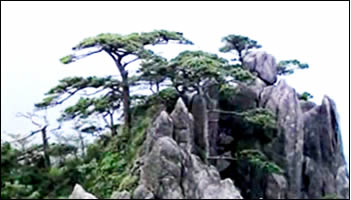
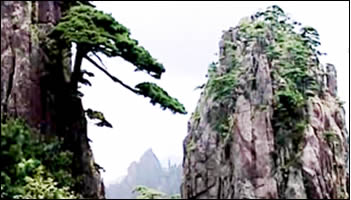
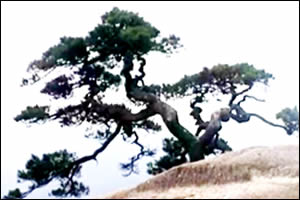
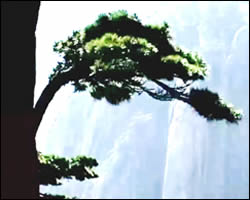
All the above pines are growing wild but all so very different.
Pines may be found growing in a very large variety of environments, ranging from semi-arid desert to rainforests, from sea level up to 5,000 metres and from the coldest to the hottest climates on Earth. They frequently occur in mountainous areas with reasonable soil and at least some water. Pines grow well in acid soils, and some also on an alkaline medium; most require good drainage, preferring sandy soils, but a few (e.g. lodgepole pine) can tolerate poorly drained wet soils.
The spiral growth of branches, needles, and cones are arranged in sequence on the trunk or branch so close together that they appear to be circles. The new spring shoots, called "candles" are covered in brown or whitish bud scales and point upward at first; they later turn green and spread outward. These "candles" offer foresters and bonsai enthusiasts’ alike, information on the health and vigour of the trees.
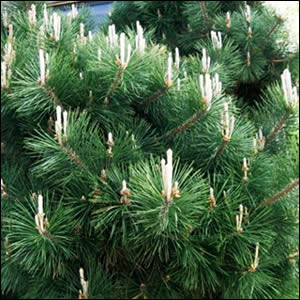
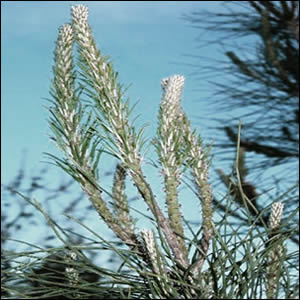
Candles in late spring.
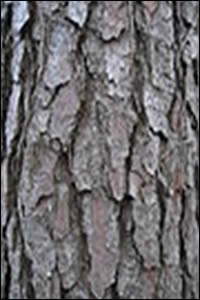

The bark of most pines is usually thick and scaly, but some species do have a thinner, flaky bark.
The branches are produced in regular whorls, a very tight spiral but appearing like a ring of branches arising from the same point. Many pines produce just one such whorl of branches each year from buds at the tip of the year's new shoot, but others are multinodal, producing two or more whorls of branches per year.
Foliage takes the form of needles. Pines have four stages of needle growth:-
- Seed leaves (cotyledons) on seedlings.
- Juvenile leaves, which follow immediately on seedlings and young plants, are 2 – 6 cm long, single, green or often blue-green, and arranged spirally on the shoot. These are produced for six months to five years, rarely longer.
- Scale leaves, similar to bud scales, are small, brown and not photosynthetic and arranged spirally like the juvenile leaves.
- Needles, the adult leaves, are green and in clusters. The needles can number from one to seven per fascicle, but usually from two or five. Thus we speak of 2 needle pines e.g. Scots pines as opposed to 5 needle pine e.g Japanese white pines. The needles survive for between 2 and 4 years, depending on species. If a shoot is damaged (e.g. eaten by an animal or cut by a careless bonsai enthusiast), the needle fascicles just below the damage will usually produce a bud which can then replace the lost leaves. It is important to remember when needle cutting – always leave the fascicle intact.
Pines are considered to be at the top of the bonsai range, with some classic specimens many hundreds of years old still existing in Japan. They are not always easy and have very specific needs but are very rewarding and make amazing bonsai specimens.
All pines are evergreen and have an excellent appearance, even in winter. The individual needles do not persist for ever, but each species retains its needles for up to three or more years. Old needles are shed in late autumn and, to some extent, in spring. New needles are produced in spring. During this process, the tree is never without a fair complement of needles.
Varieties frequently used for bonsai:| Pinus mugo | Mugo Pine, or mountain pine |
| Pinus parviflora | Japanese White Pine, 5-needle |
| Pinus sylvestris | Scots pine |
| Pinus thunbergii | Japanese Black Pine |
| Pinus ponderosa | Yellow Pine or ponderosa pine |
| Pinus densiflora | Japanese Red pine |
| Pinus pumila | Siberian dwarf pine, 5-needle |
Pines have one or two spurts of growth in the growing season. As far as bonsai is concerned this factor is essential knowledge for training your trees.
The two varieties most often used as bonsai which produce two flushes of growth per year are both from Japan and grow near the shores. Storms often break off their new candles in June and the trees are well adapted to producing a second flush afterwards. The Japanese Black Pine is a strong tree with long, dark green, hard needles in clusters of two. It grows more or less near by the sea. The Japanese Red Pine is more delicate and slender, has softer, thinner paired needles and looks similar to the Scots Pine. It grows at a slightly higher altitude.
Pine species with only one flush of growth come from the mountains where they have adapted to harsh conditions and short growth periods. The Japanese White Pine (also named five-needle pine) is a mountain plant with soft needles in clusters of five. It is more feminine in design and found at high mountain regions. It is often grafted on Black Pine root systems, for more stable growth.
The Scots Pine grows all over Europe and even in Siberia. It has thin paired needles which can be slightly twisted and the bark in the upper part of the trunk is often reddish. The Ponderosa Pine is native to western North-America and the Rocky Mountains. It is a tall tree with very long needles in clusters of three. The bark of old Ponderosa Pines has yellow to orange or even pinkish plates with black crevices. The Mugo Pine is native to European mountains and often forms depressed shrubs on bedrock near the treeline. It has short, strong, dark green, paired needles and a dark brown bark.
Specific Bonsai care guidelines for one growth flush pines:It could prove fatal to remove all their candles at one time, so they must be treated slightly differently. Included in this category are the White Pine, Scots Pine, Ponderosa Pine and Mugo Pine.
Elongated candles should be shortened to an appropriate and even length from late spring to early summer. If there are more than two candles in the same place you can cut off all but two. In autumn you can remove surplus shoots. Where more than two are growing from the same point, select two which are growing sideways and in the desired direction and are of similar size and strength to form a V-shape. Remove the others. In strong parts of the tree cut excess old needles to balance the growth of the tree.
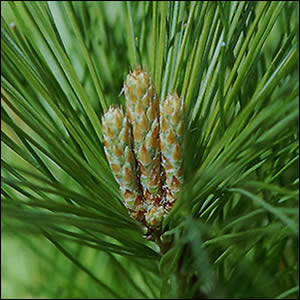
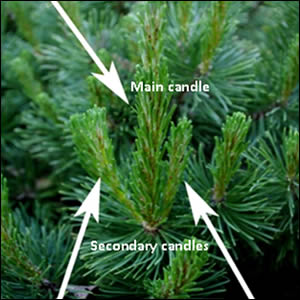

Here you can see the two new growth tips in the spring. The centre candle is very long and should be removed.
This is done to develop the two remaining branches and achieve more ramification.

Now here is the same branch with the old needles cut off. We cut the old needles because if you pull them off, you remove some of the fine skin to the branch with it. These tiny little injuries can compound into a dead branch.
- Place the pines outside in full sun to support healthy growth; needles grow longer if the tree gets insufficient sunlight; it is providing a greater area to photosynthesize. Protection should be given in wet winters to stop them remaining too wet and from frost if in shallow containers that will freeze.
- Be careful not to over-water as bonsai pines dislike permanent moisture. Good drainage is required. Protect the trees from excess rain when the shoots are developing; too much water will make the needles grow longer than necessary.
- Fertilize weak trees regularly, healthy trees only from early spring to late summer - you do not want excessive growth
- Wire from early autumn to spring, just after candles are shortened in early to mid-summer. Keep the top of a pine thinned relative to the bottom.
- It is best to repot in spring just after buds begin to break. You can also repot pines in late summer or early autumn when temperatures are not so high anymore but there is still enough time for the tree to regrow fine roots before winter. Keep root reduction to a minimum.
- Pines look best in non-glazed containers of subdued colour. Straight-sided containers, whether oval, round or rectangular seem to work well.
- A detail that really helps to give a pine a mature appearance is the removal of all needles that come from underneath the branches. Retain only needles that grow up from the tops of the branches. This detail frequently is overlooked but worth the time expended. Cutting is safer than plucking.
Needle plucking/cutting and adventitious buds:
This is not just part of summer maintenance but all season work. Doing this work earlier enables the tree to progress ready for summer maintenance. It is the development of these buds that is essential to maintain a good shape on an established pine and create shape on younger specimens.
Adventitious buds are buds that emerge in areas where they do not usually develop. They usually arise from latent or dormant buds located in the leaf axils of younger stems and will remain indefinitely until they are removed. Adventitious buds help to replace lost branches.
All end-of-stem buds are generally called “terminal buds”.


To achieve adventitious buds:
- It is essential to remove the previous year’s needles in late summer or early autumn, leaving only those that have developed that year.
- Work slowly, pulling only one needle at a time either very carefully pulling with your fingers or carefully cut just outside the needle sheath to avoid damaging the needle base. Cut the old needles because if you pull them off, you remove some of the fine skin to the branch with it. These tiny little injuries can compound into a dead branch.
Pulling backwards on pine needles isn’t recommended as it can tear the skin of the branch. This is especially true for younger needles and it opens a tear in the branch.
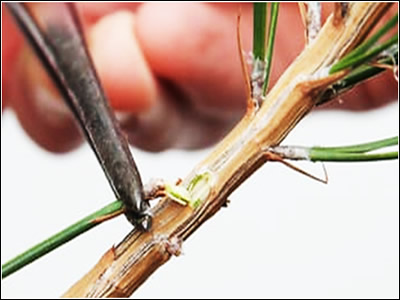
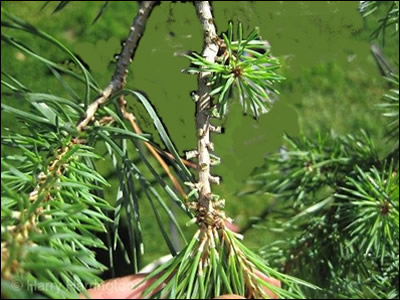
A branch after needle-plucking.
With needle plucking or cutting, timing is important. It should be done after the new growth of the current growing-season has extended, that is from late summer until autumn.
Both old and new needles are plucked according to their position on the tree. The basic principal behind needle plucking is that the more foliage or needles a branch has, the more vigorous it is; by reducing the number of needles in a vigorous area, such as the apex, then the vigour is distributed more evenly. Leave less needle-pairs on the upper shoots and more on the weaker, lower and inner shoots. Sometimes it is wise that no needles are plucked from inner shoots to preserve their vigour.
The previous year’s needles have been removed; they can be plucked by hand or cut away, leaving a small stub behind. These stubs are now potential sites for new buds and shoots to emerge next spring.
To do this task correctly, the tree should be methodically worked over, branch-by-branch.
This balances vigour and energy distribution as well as improving aeration and light dispensation.
If you do your needle picking conscientiously in the winter, in the spring you will find adventitious buds shooting all over the place even on really old wood.
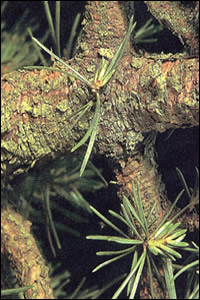
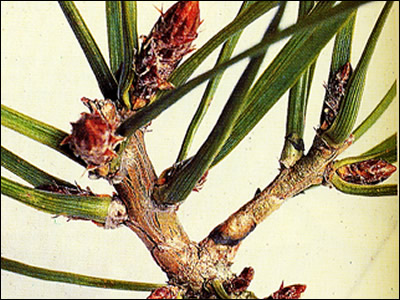
NEXT SPRING
All the eye (adventitious) buds that are produced will rapidly become developing new candles waiting for you to reduce in the summer.
Pests and diseases:Pinus bonsai are affected by aphids, spider mites, scale or caterpillars. Sometimes they are also attacked by fungal diseases and root rot. Use specific appropriate pesticides. Pines can very quickly deteriorate from the moment the first sign of disease is visible, but if placed in a sunny position and are cared for properly they tend to be very healthy.

This is not disease it is a very normal feature
on white pine branches, showing annual yellowing and
abscission of older foliage in the autumn.